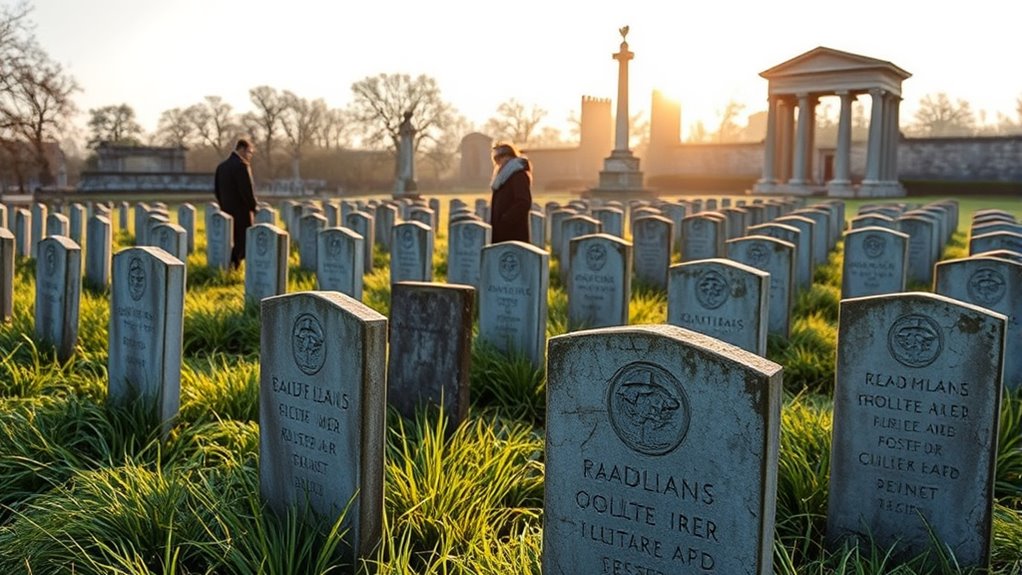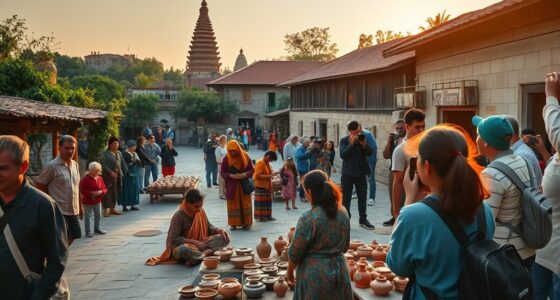Remembrance travel lets you connect personally with history by visiting war memorials and historic sites that honor sacrifices and promote understanding. You might explore famous battlefields, memorial parks, or museums that serve as powerful symbols of resilience and national memory. Many travelers are motivated by family connections, education, or a desire to preserve heritage. If you’re curious about how these sites impact culture and tourism, there’s much more to discover.
Key Takeaways
- Visiting war memorials and historic sites honors sacrifices, fosters reflection, and deepens understanding of past conflicts.
- Key sites like Ypres, the Somme, and the Menin Gate serve as powerful symbols of remembrance and resilience.
- War tourism boosts local economies through visitor spending and supports cultural preservation efforts.
- Digital tools like virtual reality enhance accessibility and immersive educational experiences at historic sites.
- Centenary commemorations significantly increase visitor engagement, promoting awareness and intergenerational remembrance.
The Rise of War Memorial Tourism and Its Significance
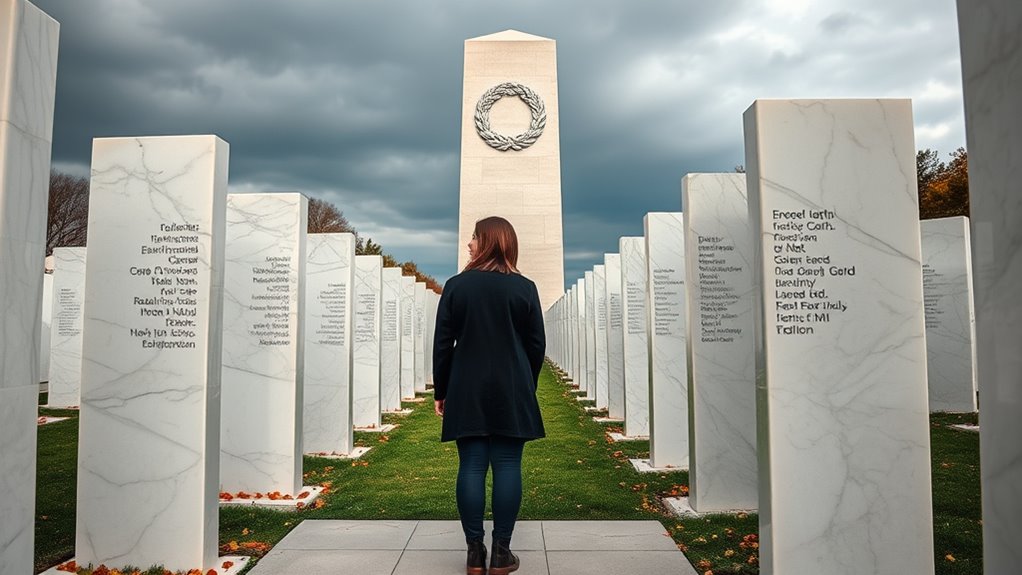
The rise of war memorial tourism reflects a growing global interest in remembering and understanding past conflicts. This trend emphasizes the importance of historical preservation, ensuring these sites remain meaningful for future generations. As more people visit memorials, they foster cultural diplomacy by promoting dialogue and mutual understanding among diverse nations. The increasing market size, projected to reach nearly USD 693 million by 2029, shows how public engagement with war history fuels economic growth and community involvement. Visitors seek not only to pay tribute but also to connect with shared histories. These sites serve as powerful tools to educate, heal, and unite, transforming remembrance into a crucial aspect of cultural diplomacy and collective memory worldwide. Visitor numbers and trends show a steady increase, indicating a sustained and growing interest in war memorials. Additionally, heritage preservation efforts play a vital role in maintaining the integrity and educational value of these historic sites for future generations.
Key Historic Sites Around the Globe

Around the world, key historic sites like battlefields, cemeteries, and memorial parks invite you to reflect on past conflicts. These sites honor those who fought and offer powerful stories that shape our understanding of history. Exploring them connects you to the sacrifices made across different nations and eras. Most-Visited War Memorials in the U.S. demonstrate the enduring importance of remembrance and national memory.
Iconic Battlefields and Cemeteries
Iconic battlefields and cemeteries serve as powerful reminders of the sacrifices made during the world’s deadliest conflicts. They hold immense cultural significance, preserving the history of devastating battles like Ypres and the Somme. Tyne Cot Cemetery in Belgium, the largest Commonwealth war cemetery, honors thousands of soldiers, while the Menin Gate memorial commemorates over 54,000 missing soldiers. In France, the Thiepval Memorial and Pozieres battlefield mark key moments in WWI, emphasizing the importance of historical preservation. These sites help keep alive the memory of those who fought and died, fostering understanding and reflection. Visiting these locations allows you to connect with history firsthand, paying tribute to sacrifices that shaped the modern world. They stand as enduring symbols of remembrance and resilience. Many of these sites are maintained by dedicated organizations to ensure their preservation for future generations, highlighting the importance of cultural heritage preservation.
Memorial Parks and Museums
Memorial parks and museums stand as powerful tributes to those who fought and sacrificed in conflicts worldwide. They serve as sites of cultural preservation, safeguarding history through memorial architecture that reflects a nation’s values and memories. For example, Victory Park in Moscow combines striking architecture with museums honoring WWII heroes, while the Irish National War Memorial Gardens preserve Ireland’s history with symbolic gardens and inscribed walls. The Auckland War Memorial Museum integrates historic architecture with exhibits honoring fallen soldiers. International sites like the Redipuglia War Memorial in Italy and the Garden of Remembrance in Dublin highlight collective memory through their design and artifacts. These parks and museums offer immersive experiences, connecting visitors to the past and ensuring that sacrifices are never forgotten. Incorporating authentic design elements can deepen the emotional impact of these memorials and enhance visitors’ understanding of history.
Visitor Demographics and Motivations for War Tourism
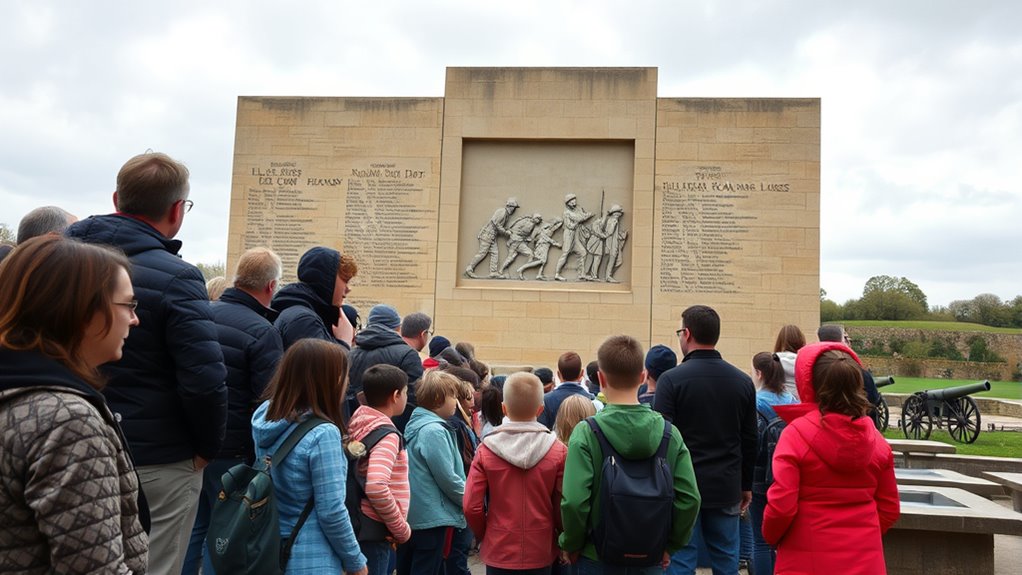
As a visitor, your personal connections to historical events often motivate your interest in war tourism, whether through family ties or a desire to honor loved ones. Educational goals and peace-building efforts also drive many travelers to seek understanding and reconciliation at these sites. Additionally, international family connections can inspire journeys to explore shared histories across borders. Research indicates that a significant portion of travelers are motivated by a sense of patriotism and a wish to connect with their national heritage. Understanding the role of contrast ratio in visual presentation can deepen appreciation for the historical displays and exhibits encountered during these visits.
Personal Historical Connections
Have you ever wondered what draws different groups of people to war tourism? It often comes down to personal historical connections. Many visitors seek to explore their family’s military past or uncover links to specific conflicts. These connections can deepen their experience and foster a sense of identity. You might find yourself collecting war souvenirs or admiring memorial architecture that symbolizes sacrifice. Others visit to honor loved ones lost in war or to understand the circumstances that shaped their ancestors’ lives. Some are motivated by curiosity about their heritage, while others aim to reflect on shared history. Whether for personal remembrance or national pride, these motivations create a powerful link between visitors and the sites they explore. Additionally, the diversification in investment portfolios of war memorials and historic sites can attract a broader range of visitors interested in cultural and financial significance.
Educational and Peace Goals
Why do people visit war sites? You’re often motivated by educational and peace goals, seeking to understand historical events and sacrifices. These sites use exhibits and guided tours to deepen knowledge about conflicts, their causes, and consequences, fostering reflection beyond military facts. Memory politics influence how interpretations emphasize peace and reconciliation, reminding visitors of war’s futility. Propaganda strategies are sometimes evident, shaping narratives around patriotism or anti-war messages to promote social healing. Visitors of diverse ages, especially middle-aged and older adults, often connect personally with history, while younger generations visit for educational purposes. Many aim to honor ancestors, support peace initiatives, or gain a broader understanding of global conflicts. This blend of motives underscores how war tourism serves both learning and peace-building objectives. Additionally, the portrayal of conflict through historical narratives can significantly influence visitors’ perceptions and attitudes toward peace and reconciliation efforts.
International Family Ties
Family connections play a significant role in shaping war tourism experiences across the globe. Many visitors are driven by personal ties, such as descendants of veterans or those with ancestral heritage. These trips often focus on intergenerational storytelling and heritage preservation, strengthening family bonds. You might visit battlefields or memorials to honor relatives who served, creating shared memories that pass down stories. Emotional bonds and family histories motivate many to connect with their roots through these journeys. Additionally, families often travel together to educate younger generations about their heritage and sacrifices. These motivations foster a deeper understanding of personal and collective history, making war tourism a meaningful way to preserve family legacy and keep the memories alive across generations.
Cultural significance and sacred sites also inspire many to visit memorials, as they serve as powerful symbols of collective remembrance and history.
Economic Contributions of Battlefield and Memorial Visits
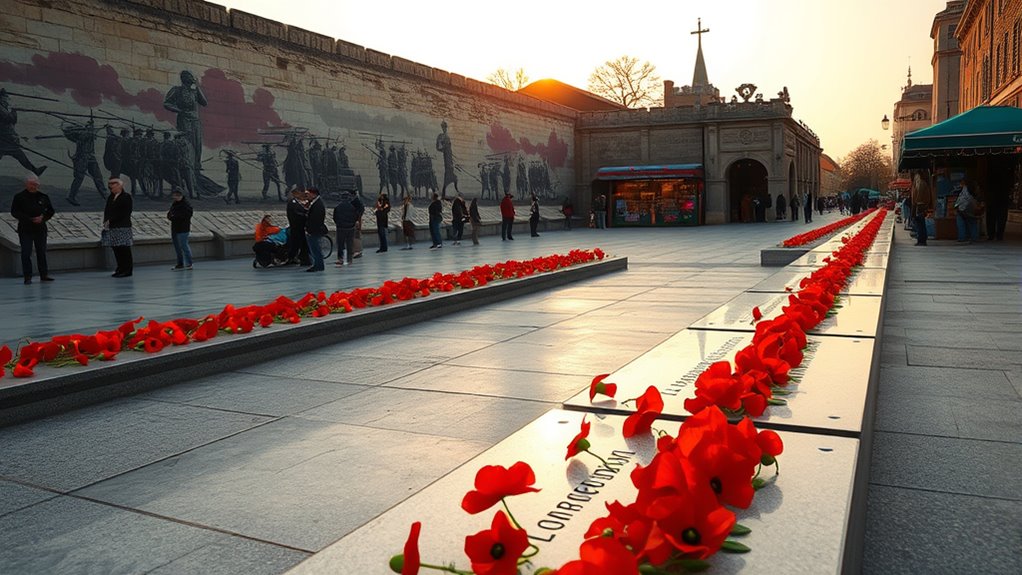
Visiting battlefield and memorial sites considerably boosts local economies by generating substantial spending and creating jobs. The economic impact of these sites is evident in visitor statistics, with millions of people exploring historic locations each year. For example, Gettysburg National Military Park attracted over 1 million visitors in 2015, supporting 1,404 jobs and generating $107.7 million in local sales. Similarly, Colonial National Historical Park drew more than 3.3 million visitors, contributing $67.3 million to the local economy and supporting nearly 1,000 jobs. Civil War sites like Fredericksburg and Spotsylvania also generated significant sales and employment. Overall, war memorial and battlefield tourism produce multimillion-dollar impacts, playing an essential role in regional economic vitality and community sustainability. Incorporating sustainable tourism practices can further enhance the positive economic contributions of these historic sites.
The Role of Government and Institutions in Promoting Remembrance Travel
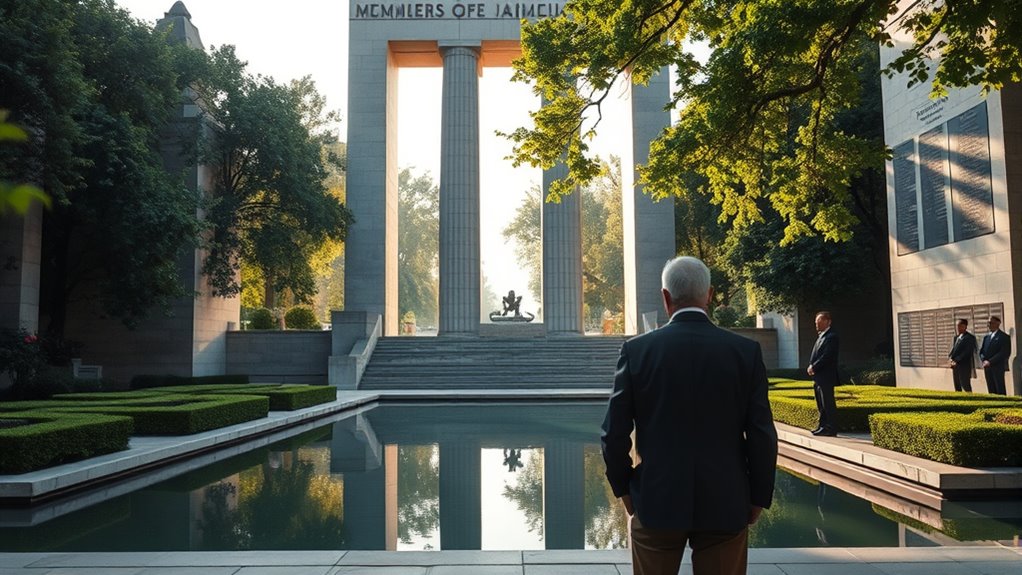
Government and institutions play a crucial role in promoting remembrance travel by establishing partnerships, funding infrastructure, and coordinating commemorative efforts. They create bilateral agreements, such as memoranda between countries, to develop war memorial sites and enhance pilgrimages. They also support digital archives, making historical records accessible worldwide, and boost souvenir markets by encouraging the sale of commemorative items.
- Develop remembrance trails with signage, museums, and amenities
- Fund site rehabilitation and expansion projects
- Lead national efforts through ministries of defense and cultural departments
- Foster international collaborations to strengthen diplomatic ties
- Provide grants for memorial maintenance and community projects
These initiatives help preserve historic sites, attract visitors, and deepen cultural connections, ensuring remembrance remains a essential part of tourism.
Notable Trends and Growth Patterns in War Tourism Markets
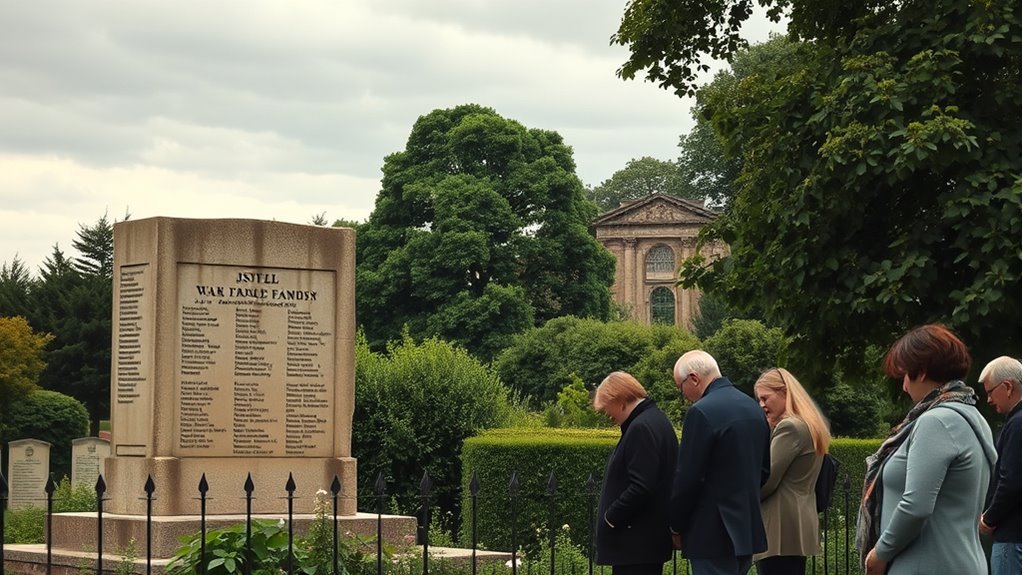
The war tourism market has experienced steady growth driven by increasing interest in battlefield sites, military museums, and memorials that offer immersive and educational experiences. Virtual reality technology plays a key role, enabling visitors to explore historic sites remotely or enhance in-person visits, making heritage preservation more accessible. This trend supports the expansion of heritage tourism, especially in regions like North America, Europe, and Asia Pacific, where battlefield tours and memorial visits are popular. Growth is fueled by diverse consumer segments, including history enthusiasts, veterans, and students, with digital platforms and curated group tours increasing engagement. As the market approaches USD 927 million by 2035, the integration of virtual reality and heritage preservation efforts will continue to shape the future of war tourism, making it more immersive and sustainable. Additionally, understanding size restrictions for tiny houses can inform strategies for developing accessible and compliant heritage sites and memorials in various regions.
Impact of Centenary Commemorations on Visitor Numbers
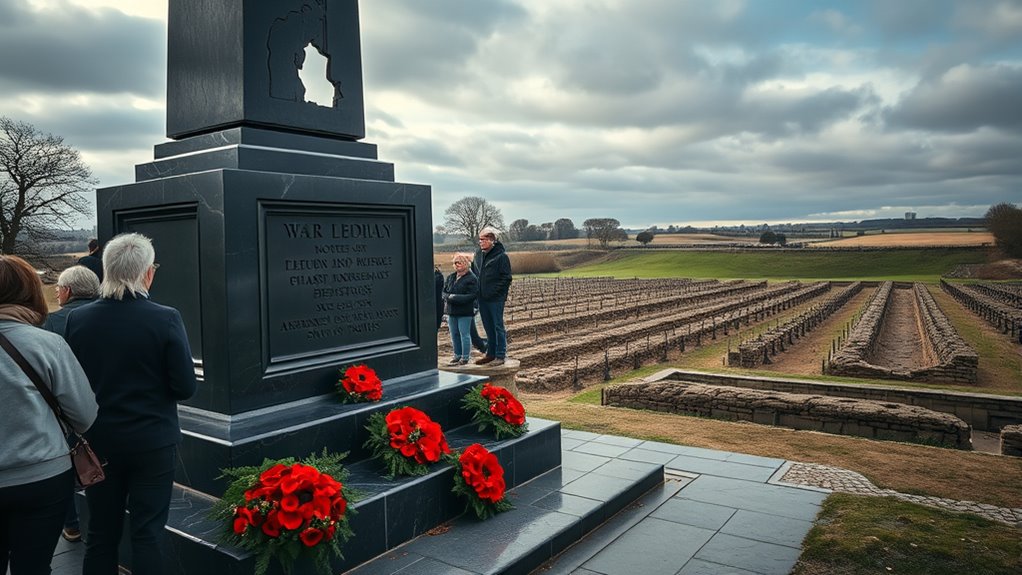
Have you noticed how centenary commemorations substantially boost visitor numbers at war sites? During these milestone years, visitation rates often double or triple, driven by increased publicity and funding. For example, in 2018, WWI battlefield tourism in France saw over 3.9 million visits, supporting cultural and heritage preservation.
- Engagement with commemorations encourages repeated visits, deepening understanding of history.
- Tourism spikes boost local economies through spending on accommodations, dining, and souvenirs.
- Increased visitor numbers lead to additional investment in site conservation and interpretive infrastructure.
- The heightened interest attracts diverse demographics, including older adults and history enthusiasts.
- Centenary events raise awareness, expanding the reach of heritage preservation efforts beyond traditional audiences.
These surges highlight how centenaries serve as powerful catalysts for maintaining historical memory and strengthening cultural preservation.
Educational and Cultural Exchange Through War Memorial Visits
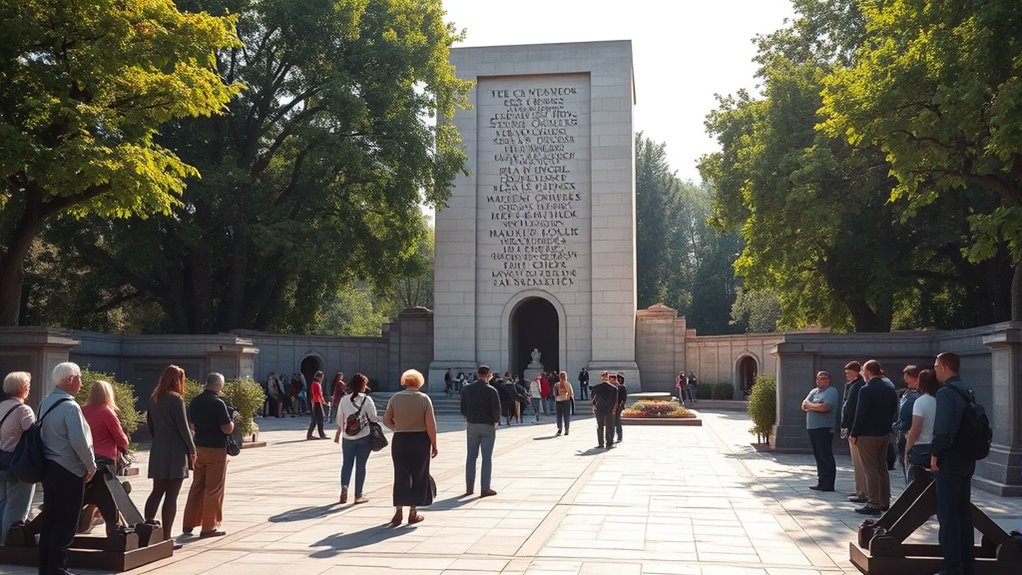
Centenary commemorations not only draw large crowds but also open opportunities for meaningful educational and cultural exchanges at war memorials. When you visit, you participate in memory preservation and foster cultural diplomacy by understanding diverse narratives and shared sacrifices. These visits deepen your historical understanding through immersive exhibits and personal stories, especially benefiting disadvantaged students. Engaging with artifacts and memorial spaces improves retention and critical thinking. Moreover, recognizing the significance of cybersecurity vulnerabilities associated with digital memorials and information sharing can help ensure these sites remain protected and accessible.
Future Perspectives and Opportunities in Remembrance Tourism
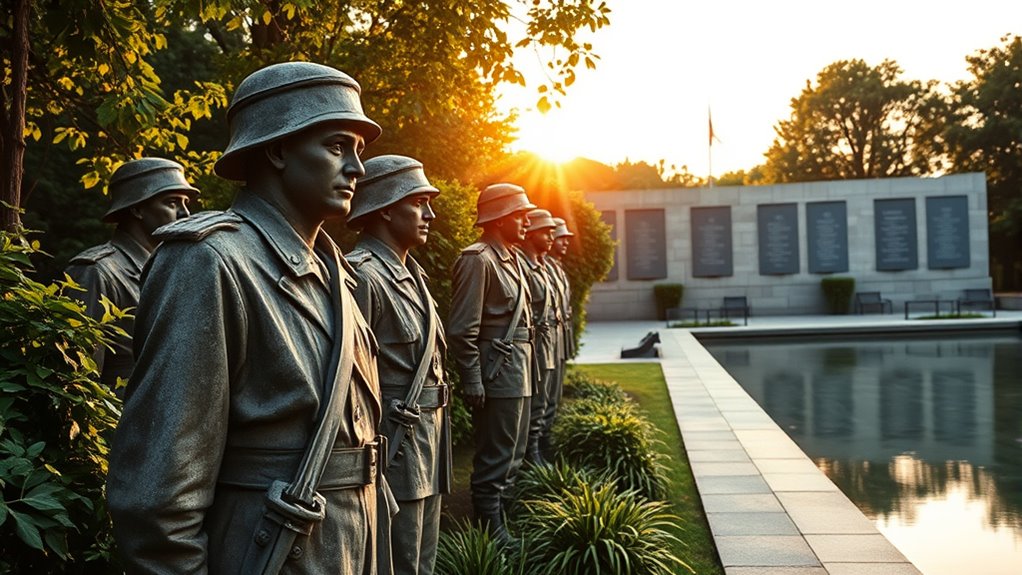
Remembrance tourism is poised for significant growth as technological innovations, expanding global interest, and sustainability initiatives reshape how you engage with memorial sites. Advances like VR and AR create immersive experiences, making history more vivid. Mobile apps provide guided tours and interactive content, increasing accessibility. Digital archives and online platforms enable virtual visits, broadening reach. Integration of AI personalizes your experience and helps manage crowds effectively. Meanwhile, sustainability initiatives focus on preserving fragile sites through visitor limits, eco-friendly infrastructure, and conservation education. These efforts make certain that future generations can continue to reflect on history responsibly. Additionally, creativity is being harnessed to develop innovative ways of storytelling and engaging visitors. As remembrance tourism diversifies and globalizes, opportunities for cross-cultural exchange and inclusive storytelling grow, allowing you to connect more deeply with shared histories while supporting the preservation of these meaningful sites.
Frequently Asked Questions
How Do War Memorials Influence National Identity and Collective Memory?
War memorials shape your national identity by serving as powerful cultural symbolism that reinforces shared values like sacrifice and patriotism. They influence your collective memory by anchoring important historical events in public consciousness, creating a sense of continuity. Through memorials, you connect with past struggles, honoring those who served, while also reflecting on diverse perspectives. This ongoing remembrance helps define your society’s core ideals and strengthens a unified sense of belonging.
What Are the Best Practices for Sustainable and Respectful War Tourism?
For sustainable and respectful war tourism, you should prioritize memorial conservation by supporting policies that protect site authenticity and cultural significance. Engage with local communities and stakeholders to ensure inclusive planning, and adopt environmentally responsible practices like renewable energy and waste management. Encourage visitors to behave respectfully, reflecting on the site’s history with mindfulness. By balancing preservation, community involvement, and eco-friendly measures, you help uphold the dignity and integrity of war memorials for future generations.
How Do Local Communities Benefit From War Memorial Tourism?
You benefit from war memorial tourism through local economic growth and community engagement. When visitors come, they spend money on local businesses, creating jobs and boosting revenue. This support helps improve community infrastructure, like roads and facilities, fostering pride and shared heritage. Engaging with these sites also encourages cultural events and education, strengthening community ties and ensuring the preservation of history for future generations.
Are There Safety Concerns for Visitors at Active or Sensitive Sites?
Have you ever wondered about visitor safety at active or sensitive sites? These locations pose safety concerns, requiring vigilant site security to protect visitors from potential hazards like unexploded ordnance or restricted areas. Crowded conditions can also increase accident risks. Ensuring clear signage, controlled access, and emergency plans helps safeguard visitors and maintain the site’s integrity. Are you prepared to prioritize safety while respecting the site’s solemnity?
How Does Virtual or Augmented Reality Enhance Remembrance Travel Experiences?
Virtual tours and immersive technology transform remembrance experiences by making history more vivid and engaging. You can explore war stories from different perspectives, with realistic simulations that recreate battlefield conditions. This immersive technology deepens your emotional connection and understanding of the past. It also makes remembrance accessible to everyone, regardless of physical ability or location, offering a powerful, interactive way to honor and learn about history without leaving your space.
Conclusion
As you explore war memorials and historic sites, you’ll find that remembrance travel connects us all through shared history and reflection. Coincidentally, as these sites draw more visitors, they remind us how history shapes our present and future. Whether you’re seeking understanding or paying respects, your journey adds to a global tapestry of remembrance. In this way, your visit becomes part of a larger story—one of memory, learning, and hope for tomorrow.
